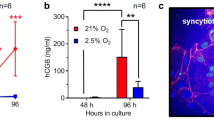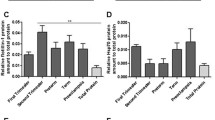Abstract
Objective
The vascular cell adhesion molecule-1 (VCAM-1) is a member of the immunoglobulin gene superfamily and is expressed principally on endothelial cells. The present study was undertaken to compare the expression and secretion of VCAM-1 from normal pregnancies and those complicated by fetal growth restriction (FGR).
Methods
Placentas from first-trimester (FT) (n = 17), normal term (n= 19), and FGR (n = 16) patients were collected immediately after elective cesarean delivery. VCAM-1 mRNA expression profiles by reverse transcriptase polymerase chain reaction, protein levels by enzyme-linked immunosorbent assay using explant culture in vitro, and its cellular localization by confocal microscopy were compared between FGR and normal placentas.
Results
Functionally active placental explants were used to detect immunoreactive VCAM-1 in conditioned media of all the samples from the three groups. The mean levels of VCAM-1 produced by FT villi were found to be 1.9-, 1.7-, and 1.5-fold higher (P < .02) than term villi at 24, 48, and 72 hours of culture, respectively. Conversely, the respective mean levels of VCAM-1 produced by FGR placental villi were 2.3-, 2.5-, and 2.0-fold lower than levels of the normal term placental villi (P<.05). The secretion profiles of VCAM-1 from FT, term, and FGR villi correlated well with the mRNA levels; the amount secreted in FT villi was twice that of term villi. Moreover, mRNA transcripts from FGR pregnancies showed significantly decreased expression, in conformity with explant results.
Conclusions
The presence of VCAM-1 in placental villi and down-regulation of its production at term indicate that VCAM-1 production is specific to developmental stage. The decreased VCAM-1 expression in FGR pregnancy could be attributed to the uteroplacental deficiency that is characteristics of this condition.
Similar content being viewed by others
References
Fisher SJ, Damsky CH. Human cytotrophoblast invasion. Semin Cell Biol 1993;4:183–188
Bischof P, Meisser A, Campana A. Mechanisms of endomentrial control of trophoblast invasion. J Reprod Fertil 2000;55(Suppl):65–71.
Chakraborty C, Gleeson LM, McKinnon T, Lala PK. Regulation of human trophoblast migration and invasiveness. Can J Physiol Pharmacol 2002;80:116–124.
Lyall F. The human placental bed revisited. Placenta 2002;23:555–562.
Hession C, Tizard R, Vassallo C, et al. Cloning of an alternate form of vascular cell adhesion molecule-1 (VCAM1). J Biol Chem 1991;266:6682–6685.
Imhof BA, Dunon D. Leukocyte migration and adhesion. Adv Immunol 1995;58:345–416.
Gearing AJ, Newman W. Circulating adhesion molecules in disease. Immunol Today 1993;14:506–512.
Banks RE, Gearing AJ, Hemingway IK, Norfolk DR, Perren TJ, Selby PJ. Circulating intercellular adhesion molecule-1 (ICAM-1), E-selection and vascular cell adhesion molecule-1 (VCAM-1) in human malignancies. Br J Cancer 1993;68:122–124.
Koizumi A, Hashimoto S, Kobayashi T, Imai K, Yachi A, Horie T. Elevation of serum soluble vascular cell adhesion molecule-1 (sVCAM-1) levels in bronchial asthma. Clin Exp Immunol 1995;101:468–473.
Wellicome SM, Kapahi P, Mason JC, Lebranchu Y, Yarwood H, Haskard DO. Detection of a circulating form of vascular cell adhesion molecule-1: Raised levels in rheumatoid arthritis and systemic lupus erythematosus. Clin Exp Immunol 1993;92:412–418.
Boldt J, Muller M, Heesen M, Neumann K, Hempelmann GG. Influence of different volume theapies and pentoxifylline infusion on circulating soluble adhesion molecules in critically ill patients. Crit Care Med 1996;24:385–391.
Pigott R, Dillon LP, Hemingway IH, Gearing AJ. Soluble forms of E-selectin, ICAM-1 and VCAM-1 are present in the supernatants of cytokine activated cultured endothelial cells. Biochem Biophys Res Commun 1992;187:584–589.
Ryan DH, Nuccie BL, Abboud CN, Winslow JM. Vascular cell adhesion molecule-1 and the integrin VLA-4 mediate adhesion of human B cell precursors to cultured bone marrow adherent cells. J Clin Invest 1991;88:995–1004.
Freedman AS, Munro JM, Morimoto C, et al. Follicular non-Hodgkin’s lymphoma cell adhesion to normal germinal centers and neoplastic follicles involves very late antigen-4 and vascular cell adhesion molecule-1. Blood 1992;79:206–212.
Lyall F, Greer IA, Boswell F, Macara LM, Walker JJ, Kingdom JC. The cell adhesion molecule, VCAM-1, is selectively elevated in serum in pre-eclampsia: Does this indicate the mechanism of leucocyte activation? Br J Obstet Gynaecol 1994;101:485–487.
Heyl W, Handt S, Reister F, et al. Elevated soluble adhesion molecules in women with pre-eclampsia. Do cytokines like tumour necrosis factor-alpha and interleukin-1beta cause endothelial activation. Eur J Obstet Gynecol Reprod Biol 1999;86:35–41.
Bretelle F, Sabatier F, Blann A, et al. Maternal endothelial soluble cell adhesion molecules with isolated small for gestational age fetuses: Comparison with pre-eclampsia. Br J Obstet Gynecol 2001;108:1277–1282.
Krauss T, Emons G, Kuhn W, Augustin HG. Predictive value of routine ciruclating soluble endothelial cell adhesion molecule measurements during pregnancy. Clin Chem 2002;48:1418–1425.
Lyall F, Hayman RG, Ashworth JR, Duffie E, Baker PN. Relationship of cell adhesion molecule expression to endotheliumdependent relaxation in normal pregnancy and pregnancies complicated with preeclampsia or fetal growth restriction. J Soc Gynecol Investig 1999;6:196–201.
Kliman HJ, Feinberg RF, Haimowitz JE. Human trophoblast endothelial interactions in an in vitro suspension culture system. Placenta 1990;11:349–367.
Rajashekhar G, Loganath A, Roy AC, Wong YC. Expression and localization of angiogenin in plancenta: Enhanced levels at term over first trimester villi. Mol Reprod Dev 2002;62:159–166.
Ali S, Kaur J, Patel KD. Intercellular cell adhesion molecule-1, vascular cell adhesion molecule-1, and regulated on activation normal T cell expressed and secreted are expressed by human breast carcinoma cells and support eosinophil adhesion and activation. Am J Pathol 2000;157:313–321.
Polte T, Newman W, Gopal TV. Full length vascular cell adhesion molecule 1 (VCAM-1). Nucleic Acids Res 1990;18:5901–5901.
Djurovic S, Schjetlein R, Wisloff F, Haugen G, Berg K. Increased levels of intercellular adhesion molecules and vascular cell adhesion molecules in pre-eclampsia. Br J Obstet Gynaecol 1997;104:466–470.
Phocas I, Rizos D, Papoulias J, Xyni K, Sarandakou A, Salamalekis E. A comparative study of serum soluble vascular cell adhesion molecule-1 and soluble intercellular adhesion molecule-1 in preeclampsia. J Perinatol 2000;20:114–119.
Zygmunt M, Boving B, Wienhard J, et al. Expression of cell adhesion molecules in the extravillous trophoblast is altered in IUGR. Am J Reprod Immunol 1997;38:295–301.
Zhou Y, Damsky CH, Fisher SJ. Pre-eclampsia is associated with failure of human cytotrophoblasts to mimic a vascular adhesion phenotype. One cause of defective endovascular invasion in this syndrome? J Clin Invest 1997;99:2152–2164.
Damsky CH, Fitzgerald M, Fisher SJ. Distribution patterns of extra cellular matrix components and adhesion receptors are intrinsically modulated during first trimester cytotrophoblast differentiation along the invasive pathway, in vivo. J Clin Invest 1992;89:210–222.
Damsky CH, Sutherland AE, Fisher SJ. Adhesive interactions in early mammalian embryogenesis, implantation and placentation. FASEB J 1993;7:1320–1328.
Damsky CH, Librach C, Lim KH, et al. Integrin switching regulates normal trophoblast invasion. Development 1994;120:3657–3666.
Alexander C, Werb Z. Extra cellular matrix degradation. In: Hay ED, ed. Cell biology of extra cellular matrix. New York Plenum Press, 1991;255–302.
Raynor BD, Parthasarathy S. Maternal serum vascular cell adhesion molecule concentration during pregnancy. J Soc Gynecol Investig 1997;4:78–80.
Johnson MR, Anim-Nyame N, Johnson P, Sooranna SR, Steer PJ. Does endothelial cell activation occur with intrauterine growth restriction? Br J Obstet Gynecol 2002;109:836–839.
Zhou Y, Fisher SJ, Janatpour M, et al. Human cytotrophoblasts adopt a vascular phenotype as they differentiate. A strategy for successful endovascular invasion? J Clin Invest 1997;99:2139–2151.
Jaakkola K, Jokimaa V, Kallajoki M, Jalkanen S, Ekholm E. Pre-eclampsia does not change the adhesion molecule status in the placental bed. Placenta 2000;21:133–141.
Tziotis J, Malamitsi-Puchner A, Vlachos G, Creatsas G, Michalas S. Adhesion molecules expression in the placental bed of pregnancies with pre-eclampsia. Br J Obstet Gynecol 2002;109:197–201.
Lyall F, Greer IA, Boswell F, Young A, Macara LM, Jeffers MD. Expression of cell adhesion molecules in placentae from pregnancies complicated by pre-eclampsia and intrauterine growth retardaton. Placenta 1995;16:579–587.
Koch AE, Halloran MM, Haskell CJ, Shah MR, Polverini PJ. Angiogenesis mediated by soluble forms of E-selectin and vascular cell adhesion molecule-1. Nature 1995;376:517–519.
William C, Schindler R, Frei U, Eckardt KU. Increases in oxygen tension stimulate expression of ICAM-1 and VCAM-1 on human endothelial cells. Am J Physiol 1999;276:H2044–H2052.
Sebire NJ, Talbert D. “Cor placentale”: placental intervillus/intravillus blood flow mismatch is the pathophysiological mechanism in severe intrauterine growth restriction due to uteroplacental disease. Med Hypotheses 2001;57:354–357.
Author information
Authors and Affiliations
Corresponding author
Additional information
This work was supported by a generous grant from the National Medical Research Council, Ministry of Health, Singapore (grant no. NMRC/0467/2000). G.R. is the recipient of a postgraduate research scholarship from the National University of Singapore.
We express our gratitude to Ms. Janet Wu, Research-coordinator, and the Labor Ward Staff, National University Hospital, Singapore, for their support in collecting placental samples and to Ms. Low Hwee Teng for her technical assistance.
Rights and permissions
About this article
Cite this article
Rajashekhar, G., Loganath, A., Roy, A.C. et al. Expression and Secretion of the Vascular Cell Adhesion Molecule-1 in Human Placenta and Its Decrease in Fetal Growth Restriction. Reprod. Sci. 10, 352–360 (2003). https://doi.org/10.1016/S1071-5576(03)00121-7
Published:
Issue Date:
DOI: https://doi.org/10.1016/S1071-5576(03)00121-7




